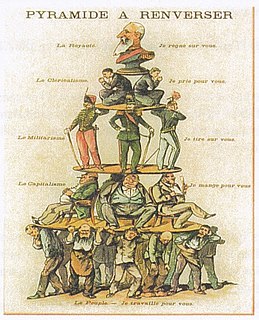Related Research Articles

Microeconomics is a branch of mainstream economics that studies the behavior of individuals and firms in making decisions regarding the allocation of scarce resources and the interactions among these individuals and firms. Microeconomics focuses on the study of individual markets, sectors, or industries as opposed to the national economy as whole, which is studied in macroeconomics.

Social psychology is the scientific study of how the thoughts, feelings, and behaviors of individuals are influenced by the presence of others as well as the internalized social norms that humans are influenced by even when they are alone. Social psychologists typically explain human behavior as a result of the relationship between mental state and social situation, studying the social conditions under which thoughts, feelings, and behaviors occur and how these variables influence social interactions.
Neorealism or structural realism is a theory of international relations that emphasizes the role of power politics in international relations, sees competition and conflict as enduring features and sees limited potential for cooperation. The anarchic state of the international system means that states cannot be certain of other states' intentions and their security, thus prompting them to engage in power politics.

International relations (IR), international studies (IS) or international affairs (IA) is the scientific study of interactions between sovereign states. It examines all activities between states—such as war, diplomacy, trade, and foreign policy—as well as relations with and among other international actors, such as intergovernmental organisations (IGOs), international nongovernmental organisations (INGOs), international legal bodies, and multinational corporations (MNCs).
International relations theory is the study of international relations (IR) from a theoretical perspective. It seeks to explain causal and constitutive effects in international politics. Ole Holsti describes international relations theories as acting like pairs of coloured sunglasses that allow the wearer to see only salient events relevant to the theory; e.g., an adherent of realism may completely disregard an event that a constructivist might pounce upon as crucial, and vice versa. The three most prominent schools of thought are realism, liberalism and constructivism.
In international relations, power is defined in several different ways. Material definitions of state power emphasize economic and military power. Other definitions of power emphasize the ability to structure and constitute the nature of social relations between actors. Power is an attribute of particular actors in their interactions, as well as a social process that constitutes the social identities and capacities of actors.

In the social sciences, social structure is the patterned social arrangements in society that are both emergent from and determinant of the actions of individuals. Likewise, society is believed to be grouped into structurally related groups or sets of roles, with different functions, meanings, or purposes. Examples of social structure include family, religion, law, economy, and class. It contrasts with "social system", which refers to the parent structure in which these various structures are embedded. Thus, social structures significantly influence larger systems, such as economic systems, legal systems, political systems, cultural systems, etc. Social structure can also be said to be the framework upon which a society is established. It determines the norms and patterns of relations between the various institutions of the society.
Becker, Howard S. (2018). Outsiders: studies in the sociology of deviance (New ed.). New York, NY: Free Press. pp. 169–172. ISBN 978-1-9821-0622-5. OCLC 1033904462.
Organizational behavior (OB) or organisational behaviour is the: "study of human behavior in organizational settings, the interface between human behavior and the organization, and the organization itself". OB research can be categorized in at least three ways:

Political psychology is an interdisciplinary academic field, dedicated to understanding politics, politicians and political behavior from a psychological perspective, and psychological processes using socio-political perspectives. The relationship between politics and psychology is considered bidirectional, with psychology being used as a lens for understanding politics and politics being used as a lens for understanding psychology. As an interdisciplinary field, political psychology borrows from a wide range of disciplines, including: anthropology, economics, history, international relations, journalism, media, philosophy, political science, psychology, and sociology.
Ego psychology is a school of psychoanalysis rooted in Sigmund Freud's structural id-ego-superego model of the mind.

State-building as a specific term in social sciences and humanities, refers to political and historical processes of creation, institutional consolidation, stabilization and sustainable development of states, from the earliest emergence of statehood up to the modern times. Within historical and political sciences, there are several theoretical approaches to complex questions related to role of various contributing factors in state-building processes.
Offensive realism is a structural theory in international relations that belongs to the neorealist school of thought and was put forward by the political scholar John Mearsheimer in response to defensive realism. Offensive realism holds that the anarchic nature of the international system is responsible for the promotion of aggressive state behavior in international politics. The theory fundamentally differs from defensive realism by depicting great powers as power-maximizing revisionists privileging buck-passing and self-promotion over balancing strategies in their consistent aim to dominate the international system. The theory brings important alternative contributions for the study and understanding of international relations but remains the subject of criticism.
A fragile state or weak state is a country characterized by weak state capacity or weak state legitimacy leaving citizens vulnerable to a range of shocks. The World Bank, for example, deems a country to be ‘fragile’ if it (a) is eligible for assistance from the International Development Association (IDA), (b) has had a UN peacekeeping mission in the last three years, and (c) has received a ‘governance’ score of less than 3.2. A more cohesive definition of the fragile state might also note a state's growing inability to maintain a monopoly on force in its declared territory. While a fragile state might still occasionally exercise military authority or sovereignty over its declared territory, its claim grows weaker as the logistical mechanisms through which it exercises power grow weaker.
Psi-theory, developed by Dietrich Dörner at the University of Bamberg, is a systemic psychological theory covering human action regulation, intention selection and emotion. It models the human mind as an information processing agent, controlled by a set of basic physiological, social and cognitive drives. Perceptual and cognitive processing are directed and modulated by these drives, which allow the autonomous establishment and pursuit of goals in an open environment.
A diversionary foreign policy, or a diversionary war, is an international relations term that identifies a war instigated by a country's leader in order to distract its population from their own domestic strife. The concept stems from the Diversionary War Theory, which states that leaders who are threatened by domestic turmoil may initiate an international conflict in order to improve their standing. There are two primary mechanisms behind diversionary war: a manipulation of the Rally Round the Flag Syndrome effect, causing an increase of national fervor from the general public, and "gambling on resurrection", whereby a leader in a perilous domestic situation takes high-risk foreign policy decisions with small chance of success but with a high reward if successful.

The cognitive-affective personality system or cognitive-affective processing system (CAPS) is a contribution to the psychology of personality proposed by Walter Mischel and Yuichi Shoda in 1995. According to the cognitive-affective model, behavior is best predicted from a comprehensive understanding of the person, the situation, and the interaction between person and situation.
Neoclassical realism is an approach to foreign policy analysis. Initially coined by Gideon Rose in a 1998 World Politics review article, it is a combination of classical realist and neorealist – particularly defensive realist – theories.
Social determinism is the theory that social interactions and constructs alone determine individual behavior.

Intergroup relations refers to interactions between individuals in different social groups, and to interactions taking place between the groups themselves collectively. It has long been a subject of research in social psychology, political psychology, and organizational behavior.
References
- Ashley, Richard A. The Political Economy of War and Peace: The Sino-Soviet-American triangle and the modern security problematique. New York: Nichols Publishing,
- Choucri, Nazli. Cyberpolitics in International Relations. Cambridge, MA: MIT Press, 2012. (in press)
- Choucri, Nazli and Daniel Goldsmith. "Lost in cyberspace: Harnessing the Internet, international relations, and global security." Bulletin of the Atomic Scientists 68 (2) pp. 70–77, (2012).
- Choucri, Nazli, in collaboration with Robert C. North. "In Search of Peace Systems: Scandinavia and the Netherlands, 1870-1970," in Bruce Russett, ed., Peace, War, and Numbers, Berkeley: Sage Publications, 239–74. 1972.
- Choucri, Nazli, Laird, Michael, and Meadows, Dennis. "Resource Scarcity and Foreign Policy: A Simulation Model of International Conflict." Cambridge, MA: MIT Center for International Studies, 1972.
- Choucri, Nazli, and Robert C. North. "Lateral pressure in international relations: Concept and theory." In Handbook of War Studies, edited by Manus I. Midlarsky, 289–326. Ann Arbor: University of Michigan Press, 1989.
- Choucri, Nazli, Robert C. North, and Suzumu Yamakage. The Challenge of Japan before World War II and After: A Study of National Growth and Expansion. London: Routledge, 1992.
- Choucri, Nazli, and Robert C. North. Nations in Conflict: National Growth and International Violence. San Francisco: W. H. Freeman, 1975.
- Herz, John H. "Idealist Internationalism and the Security Dilemma." World Politics 2, no. 2 (1950): 157–180.
- Jervis, Robert. System Effects: Complexity in Political and Social Life. Princeton, NJ: Princeton University Press, 1997.
- Levy, David L. and Peter J. Newell, eds. The Business of Global Environmental Governance. Cambridge, MA: The MIT Press, 2005.
- Lofdahl, Corey L. Environmental Impacts of Globalization and Trade: A systems study. Cambridge, MA: The MIT Press, 2002.
- Ole, Holsti R. Crisis, escalation, war. Montreal: McGill-Queens University Press, 1972.
- Pollins, Brian M., and Randall L. Schweller. "Linking the Levels: The Long Wave and Shifts in U.S. Foreign Policy, 1790-1993." American Journal of Political Science 43, no. 2 (April 1999): 431–464.
- Waltz, Kenneth. Theory of International Politics. New York: McGraw-Hill, 1979.
- Wickboldt, Anne-Katrin and Nazli Choucri. "Profiles of States as Fuzzy Sets: Refinement of Lateral Pressure Theory." In International Interaction.
- Wils, Annababette, Matilde Kamiya and Nazli Choucri. "Threats to sustainability: Simulating conflict within and between nations." System Dynamics Review 14, no. 2-3 (Fall 1998): 129–162.